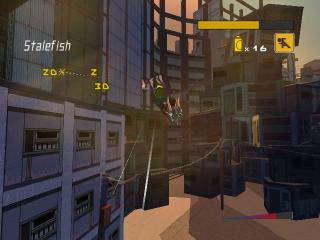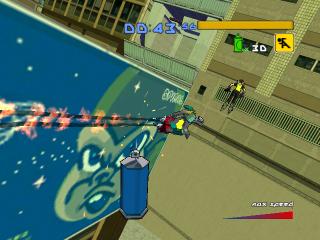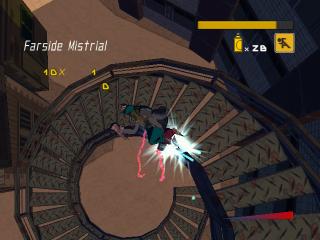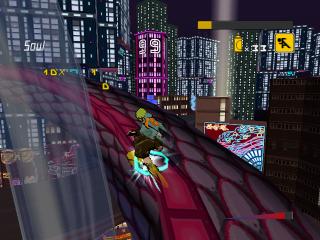 While many gamers may be confused as to whether this is
a true sequel or a merely an upgrade, these doubts re laid to rest as soon as
you plug in the disc and see the much larger environments unfold. Jet Set Radio
Future takes everything that was great about the Dreamcast’s seminal Jet Grind
Radio and ups the intensity ten-fold. While the basics of the game are somewhat
familiar, there has been so much changed and enhanced for the Xbox, that players
will find an almost entirely new experience. From a purely aesthetic standpoint,
it’s undeniable that this sequel blows the original right out of the water.
Set 10 years after the first game and again set in a futuristic Tokyo, JSRF once
again follows the adventures of an underground group of youthful rebels known as
the CC’s. Most of the characters from the first game return including the two
main ones, Gum and Beat. The objective in JSRF is the similar to the first game.
You skate through the streets of Tokyo and need to collect paint cans and other
objects such as health power-ups. When you have enough spray cans, you need to
spray or mark your areas with tags, battle the oppressive police and also to
beat out the rival gangs for street domination.
While many gamers may be confused as to whether this is
a true sequel or a merely an upgrade, these doubts re laid to rest as soon as
you plug in the disc and see the much larger environments unfold. Jet Set Radio
Future takes everything that was great about the Dreamcast’s seminal Jet Grind
Radio and ups the intensity ten-fold. While the basics of the game are somewhat
familiar, there has been so much changed and enhanced for the Xbox, that players
will find an almost entirely new experience. From a purely aesthetic standpoint,
it’s undeniable that this sequel blows the original right out of the water.
Set 10 years after the first game and again set in a futuristic Tokyo, JSRF once
again follows the adventures of an underground group of youthful rebels known as
the CC’s. Most of the characters from the first game return including the two
main ones, Gum and Beat. The objective in JSRF is the similar to the first game.
You skate through the streets of Tokyo and need to collect paint cans and other
objects such as health power-ups. When you have enough spray cans, you need to
spray or mark your areas with tags, battle the oppressive police and also to
beat out the rival gangs for street domination.
While the gameplay areas are much bigger this time
around, it’s been changed to make it more accessible. The biggest change in
JSRF comes in the controls which have been streamlined. The more intuitive
controls go a long way towards making the experience more enjoyable. The most
significant change to the interface comes in the tagging mechanism. In the first
game, you needed to make multiple motions in order to complete a tag, here you
only need to press the left shift key. While this makes it feel less like you’re
spraying the tags yourself, it makes them much easier to complete. While its
easier it’s not a complete cakewalk, because there are still large, wall
filling, multi-layered tags that require multiple spray cans to complete.
Additionally, grinding is now much easier to perform and you can grind a lot of
different objects such as poles and walls. One huge difference is the speed
boosts which now play a much larger role in the game. When you collect ten paint
cans, you can enable this which blasts you forward at an incredible speed,
blurring the entire screen for a period of time. This doesn’t really come into
play as a major new ability until you need to race against one of the rival
gangs. This gives the action in JSRF a significant shot in the arm, making this
edition seem much faster and more manic than the original game. As in JGR, you
can unlock more characters by defeating them in challenges, which are either
races or challenges where you have to copy their moves. Once these are defeated
they become playable characters that can be used in any mission. Another
significant change in the game is that all the different levels in JSRF are
linked together from the gangs centrally located garage. This is a fairly large
area as well, and is much more elaborate and organic to the proceedings than the
HQ in the first game. Here, you can practice your moves, talk to the other
characters and gain information, change settings, music and modes. Most
importantly, you can also save your progress by returning to the garage.
 JSRF’s
level designs are much larger than in the first game, in fact the layouts are
exponentially larger, more intricate and complex. Players will find a much more
expansive environment this time around, and the city streets are also filled to
overflowing with pedestrians who scatter when they see you coming their way.
This has changed the structure of the game significantly, and makes for a much
smoother flowing experience. To aid you this time around, the missions are no
longer timed, and players have an unlimited amount of freedom to explore the
levels without any constraints. This makes JSRF much more enjoyable and leads to
making things much more immersive and addictive than the first game, which is a
vast improvement to say the least. The lack of a clock makes JSRF play much
smoother than the original and lends it more of a adventure feel, de-emphasizing
the arcade aspects of the first game. Whether this tradeoff was worth it depends
on the style of game you like, but JSRF flows much smoother than the original
because the plot characters and storyline are allowed to breathe, making the
experience more interesting. In addition to the main quest, there are also some
new mini-games such as standard racing mode, capture the flag game and a
multiplayer mode where two players can battle it out. These are all fun, though
playing against the computer can be quite challenging. However, these are just
sidelights from the main quest.
JSRF’s
level designs are much larger than in the first game, in fact the layouts are
exponentially larger, more intricate and complex. Players will find a much more
expansive environment this time around, and the city streets are also filled to
overflowing with pedestrians who scatter when they see you coming their way.
This has changed the structure of the game significantly, and makes for a much
smoother flowing experience. To aid you this time around, the missions are no
longer timed, and players have an unlimited amount of freedom to explore the
levels without any constraints. This makes JSRF much more enjoyable and leads to
making things much more immersive and addictive than the first game, which is a
vast improvement to say the least. The lack of a clock makes JSRF play much
smoother than the original and lends it more of a adventure feel, de-emphasizing
the arcade aspects of the first game. Whether this tradeoff was worth it depends
on the style of game you like, but JSRF flows much smoother than the original
because the plot characters and storyline are allowed to breathe, making the
experience more interesting. In addition to the main quest, there are also some
new mini-games such as standard racing mode, capture the flag game and a
multiplayer mode where two players can battle it out. These are all fun, though
playing against the computer can be quite challenging. However, these are just
sidelights from the main quest.
The controls have also been improved significantly and each of the characters
have a much higher degree of dexterity and new abilities. One of the coolest
things about the game is that you can now perform grinds on more objects. The
designers at Smilebit have also designed the levels so that they allow for
massive grinds and some pretty spectacular combos. These are visually impressive
and when you can land them, you can earn huge points. Another quite noticeable
change is that the standard grinding and tagging parts of the mission and the
battles with the cops have been divided into distinct sections. This makes
things a little easier because it allows players to concentrate on the task at
hand. The sharper contrast between these episodes is another big improvement
from the first game where you had to simultaneously create elaborate tags while
fighting off hordes of police. The drawback to this is that the nonlinear nature
of the game makes it much harder to figure out what your next mission is going
to be. This can becomes frustrating, especially when you become stuck in some
missions. It’s not immediately apparent but the solution is to generally go to
another level of the game, defeat that level, then return. Once you do this,
paths which seemed impossible to cross are opened. JSRF’s infamous sewer level
is a prime example of this design. In this section, you can literally go on
forever in a futile attempt to find a hidden passage. You can spend a lot of
time doing this, but all you need to do is go to another section and defeat the
gang there, who will then flee to the locked section and break down the doors.
What all of this means is that the objectives aren’t nearly as obvious and
this makes the game more challenging than the first installment. This leads to a
lot of backtracking, a given the massive size of the levels, this is no small
task and it takes quite a bit of time to do this. The good news is that there
are now checkpoints, which are unlocked by spray-painting the areas. These can
then be used to save your progress in that section and you can switch characters
at the checkpoints as well which is important, since getting back to the garage
to save or switch isn’t always easy or practical.
 As
you may have guessed, the graphics and visuals this time are stunningly
brilliant, fully utilizing the power of Microsoft’s Xbox. While the use of cel-shading
in the first title was amazing, here the effect has become even more impressive.
The character animation is even smoother, with a much more fluid motion used to
brilliant effect, bringing the characters to life exceptionally well. JSRF’s
environments are, as stated earlier, much larger this time with massive
skyscrapers towering above the congested streets. The colors are vibrant,
shocking and beautiful, giving the gamer the realistic sense of being in a
stylish, hip-hop Japanese anime. A distinctly Japanese flavor permeates the game
radiates in the elaborate neon signs, strange billboards, bizarre objects and
attitude. Most importantly, while the action is incredibly manic and fast, the
game never seems to suffer the technical flaws, such as clipping, aliasing,
pop-up or slowdown that plagues games of similar ambition and design. The
graphic look of the game is amazingly sharp and there are actually, points where
the game seems to move too fast, making JSRF almost become overwhelming. For
example, there are some incredibly complicated grinds in the game where you go
from one telephone wire to another, and this can become a tad disorienting at
times. The camera system is really good and you can adjust it to view the action
from the first person when you’re standing, allowing you to soak in the game’s
amazing atmosphere. In addition, there’s an incredible blurring effect that’s
used when you speed boost, which is really amazing to see in action. While there
have been some changes made to attract a more mainstream gamer, fortunately, the
soul of the original shines through here again with extremely stylish,
incredibly hip character designs. The cutting edge outfits that the game’s
characters wear look cool and exciting, giving the game a sense of fashion and
style other games only hope to match. While its visuals are amazing, JSRF’s
soundtrack is also brilliant and innovative. The first game’s soundtrack was
shockingly cool, much cooler than anything on MTV, and this continues the legacy
featuring several distinctly underground experimental J-Pop artists. While some
of the artists return from the first game, all the tracks are new. Each one of
the songs fits the underground feel of the game perfectly and only enhances the
atmosphere. While some of the tracks might sound strange to virgin ears, most of
them are still excellent and go a long way in helping to keep the player
motivated throughout. Sega deserves credit for not hewing to the standard boring
predictable video game soundtrack, and instead opting for a much more
interesting array of music.
As
you may have guessed, the graphics and visuals this time are stunningly
brilliant, fully utilizing the power of Microsoft’s Xbox. While the use of cel-shading
in the first title was amazing, here the effect has become even more impressive.
The character animation is even smoother, with a much more fluid motion used to
brilliant effect, bringing the characters to life exceptionally well. JSRF’s
environments are, as stated earlier, much larger this time with massive
skyscrapers towering above the congested streets. The colors are vibrant,
shocking and beautiful, giving the gamer the realistic sense of being in a
stylish, hip-hop Japanese anime. A distinctly Japanese flavor permeates the game
radiates in the elaborate neon signs, strange billboards, bizarre objects and
attitude. Most importantly, while the action is incredibly manic and fast, the
game never seems to suffer the technical flaws, such as clipping, aliasing,
pop-up or slowdown that plagues games of similar ambition and design. The
graphic look of the game is amazingly sharp and there are actually, points where
the game seems to move too fast, making JSRF almost become overwhelming. For
example, there are some incredibly complicated grinds in the game where you go
from one telephone wire to another, and this can become a tad disorienting at
times. The camera system is really good and you can adjust it to view the action
from the first person when you’re standing, allowing you to soak in the game’s
amazing atmosphere. In addition, there’s an incredible blurring effect that’s
used when you speed boost, which is really amazing to see in action. While there
have been some changes made to attract a more mainstream gamer, fortunately, the
soul of the original shines through here again with extremely stylish,
incredibly hip character designs. The cutting edge outfits that the game’s
characters wear look cool and exciting, giving the game a sense of fashion and
style other games only hope to match. While its visuals are amazing, JSRF’s
soundtrack is also brilliant and innovative. The first game’s soundtrack was
shockingly cool, much cooler than anything on MTV, and this continues the legacy
featuring several distinctly underground experimental J-Pop artists. While some
of the artists return from the first game, all the tracks are new. Each one of
the songs fits the underground feel of the game perfectly and only enhances the
atmosphere. While some of the tracks might sound strange to virgin ears, most of
them are still excellent and go a long way in helping to keep the player
motivated throughout. Sega deserves credit for not hewing to the standard boring
predictable video game soundtrack, and instead opting for a much more
interesting array of music.
 So while there have been some compromises made to the
mainstream, casual gamer, the underground soul of Jet Set Radio Future still
burns. The streamlined controls make the game much easier, but the increasingly
difficult and elaborate levels make thing difficult at points. The gameplay is
still quite addictive, especially since it’s been enhanced and allows you to
grind on any objects, in such huge expansive environments which only add to the
game’s uniquely urban anime feel. Additionally, JSRF’s incredibly stylish
characters and unique environments are unmatched by any other title to date, cel-shaded
or not. Add these elements together, and you have a title that looks and feels
like no other. This is definitely one of the most singularly impressive titles
for the Xbox to date, and ranks there with the most innovative and brilliantly
addictive titles Sega has ever produced. While some of the level designs are so
large that they require excessive amounts of backtracking, players willing to
put up with this will find the frustrating aspects are worth putting up with.
Smilebit has created another masterpiece. While it’s not perfect, the
experience is unique and breathtaking. It’s not just looks, because the
gameplay is brilliant, fun and entertaining underneath. JSRF should please those
who loved the Dreamcast version because it makes what was great about the
original absolutely incredible. Grade: A+
So while there have been some compromises made to the
mainstream, casual gamer, the underground soul of Jet Set Radio Future still
burns. The streamlined controls make the game much easier, but the increasingly
difficult and elaborate levels make thing difficult at points. The gameplay is
still quite addictive, especially since it’s been enhanced and allows you to
grind on any objects, in such huge expansive environments which only add to the
game’s uniquely urban anime feel. Additionally, JSRF’s incredibly stylish
characters and unique environments are unmatched by any other title to date, cel-shaded
or not. Add these elements together, and you have a title that looks and feels
like no other. This is definitely one of the most singularly impressive titles
for the Xbox to date, and ranks there with the most innovative and brilliantly
addictive titles Sega has ever produced. While some of the level designs are so
large that they require excessive amounts of backtracking, players willing to
put up with this will find the frustrating aspects are worth putting up with.
Smilebit has created another masterpiece. While it’s not perfect, the
experience is unique and breathtaking. It’s not just looks, because the
gameplay is brilliant, fun and entertaining underneath. JSRF should please those
who loved the Dreamcast version because it makes what was great about the
original absolutely incredible. Grade: A+
- Michael Palisano

